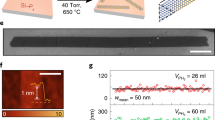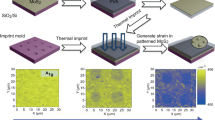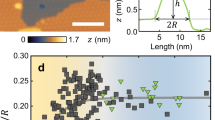Abstract
Developing a precise and reproducible bandgap tuning method that enables tailored design of materials is of crucial importance for optoelectronic devices. Towards this end, we report a sphere diameter engineering (SDE) technique to manipulate the bandgap of two-dimensional (2D) materials. A one-to-one correspondence with an ideal linear working curve is established between the bandgap of MoS2 and the sphere diameter in a continuous range as large as 360 meV. Fully uniform bandgap tuning of all the as-grown MoS2 crystals is realized due to the isotropic characteristic of the sphere. More intriguingly, both a decrease and an increase of the bandgap can be achieved by constructing a positive or negative curvature. By fusing individual spheres in the melted state, post-synthesis bandgap adjustment of the supported 2D materials can be realized. This SDE technique, showing good precision, uniformity and reproducibility with high efficiency, may further accelerate the potential applications of 2D materials.
This is a preview of subscription content, access via your institution
Access options
Access Nature and 54 other Nature Portfolio journals
Get Nature+, our best-value online-access subscription
$29.99 / 30 days
cancel any time
Subscribe to this journal
Receive 12 print issues and online access
$259.00 per year
only $21.58 per issue
Buy this article
- Purchase on Springer Link
- Instant access to full article PDF
Prices may be subject to local taxes which are calculated during checkout




Similar content being viewed by others
Data availability
The data that support the findings of this study are available from the corresponding author upon reasonable request.
Code availability
The custom code for the phase field analysis is available from the corresponding authors upon reasonable request.
References
Chhowalla, M. et al. The chemistry of two-dimensional layered transition metal dichalcogenide nanosheets. Nat. Chem. 5, 263–275 (2013).
Xu, M., Liang, T., Shi, M. & Chen, H. Graphene-like two-dimensional materials. Chem. Rev. 113, 3766–3798 (2013).
Xia, F., Wang, H., Xiao, D., Dubey, M. & Ramasubramaniam, A. Two-dimensional material nanophotonics. Nat. Photon. 8, 899–907 (2014).
Smith, A. M. & Nie, S. Semiconductor nanocrystals: structure, properties, and band gap engineering. Acc. Chem. Res. 43, 190–200 (2010).
Castro Neto, A. H., Guinea, F., Peres, N. M. R., Novoselov, K. S. & Geim, A. K. The electronic properties of graphene. Rev. Mod. Phys. 81, 109–162 (2009).
Feng, J., Qian, X., Huang, C.-W. & Li, J. Strain-engineered artificial atom as a broad-spectrum solar energy funnel. Nat. Photon. 6, 866–872 (2012).
Castro, E. V. et al. Biased bilayer graphene: semiconductor with a gap tunable by the electric field effect. Phys. Rev. Lett. 99, 216802 (2007).
Wu, W. et al. Piezoelectricity of single-atomic-layer MoS2 for energy conversion and piezotronics. Nature 514, 470–474 (2014).
Guinea, F., Katsnelson, M. I. & Geim, A. K. Energy gaps and a zero-field quantum Hall effect in graphene by strain engineering. Nat. Phys. 6, 30–33 (2009).
Zhu, H. et al. Observation of piezoelectricity in free-standing monolayer MoS2. Nat. Nanotechnol. 10, 151–155 (2015).
Wang, X. et al. Observation of a giant two-dimensional band-piezoelectric effect on biaxial-strained graphene. NPG Asia Mater. 7, e154 (2015).
Li, H. et al. Optoelectronic crystal of artificial atoms in strain-textured molybdenum disulphide. Nat. Commun. 6, 7381 (2015).
Mehboudi, M. et al. Strain and the optoelectronic properties of nonplanar phosphorene monolayers. Proc. Natl Acad. Sci. USA 112, 5888–5892 (2015).
Lee, J. E., Ahn, G., Shim, J., Lee, Y. S. & Ryu, S. Optical separation of mechanical strain from charge doping in graphene. Nat. Commun. 3, 1024 (2012).
Wei, D. et al. Synthesis of n-doped graphene by chemical vapor deposition and its electrical properties. Nano Lett. 9, 1752–1758 (2009).
Yavari, F. et al. Tunable bandgap in graphene by the controlled adsorption of water molecules. Small 6, 2535–2538 (2010).
Ci, L. et al. Atomic layers of hybridized boron nitride and graphene domains. Nat. Mater. 9, 430–435 (2010).
Feng, Q. et al. Growth of large-area 2D MoS2(1 − x)Se2x semiconductor alloys. Adv. Mater. 26, 2648–2653 (2014).
Li, H. et al. Growth of alloy MoS2xSe2(1 − x) nanosheets with fully tunable chemical compositions and optical properties. J. Am. Chem. Soc. 136, 3756–3759 (2014).
Kharche, N. & Nayak, S. K. Quasiparticle band gap engineering of graphene and graphone on hexagonal boron nitride substrate. Nano Lett. 11, 5274–5278 (2011).
Kośmider, K. & Fernández-Rossier, J. Electronic properties of the MoS2–WS2 heterojunction. Phys. Rev. B 87, 075451 (2013).
Zhang, Y. et al. Direct observation of a widely tunable bandgap in bilayer graphene. Nature 459, 820–823 (2009).
Levy, N. et al. Strain-induced pseudo-magnetic fields greater than 300 tesla in graphene nanobubbles. Science 329, 544–547 (2010).
Liu, Z. et al. Strain and structure heterogeneity in MoS2 atomic layers grown by chemical vapour deposition. Nat. Commun. 5, 5246 (2014).
Hui, Y. Y. et al. Exceptional tunability of band energy in a compressively strained trilayer MoS2 sheet. ACS Nano 7, 7126–7131 (2013).
Desai, S. B. et al. Strain-induced indirect to direct bandgap transition in multilayer WSe2. Nano Lett. 14, 4592–4597 (2014).
Mohiuddin, T. M. G. et al. Uniaxial strain in graphene by Raman spectroscopy: G peak splitting, Grüneisen parameters, and sample orientation. Phys. Rev. B 79, 205433 (2009).
Chaste, J. et al. Intrinsic properties of suspended MoS2 on SiO2/Si pillar arrays for nanomechanics and optics. ACS Nano 12, 3235–3242 (2018).
Chen, Y. et al. Growing uniform graphene disks and films on molten glass for heating devices and cell culture. Adv. Mater. 27, 7839–7846 (2015).
Rolinson, R. E. Graphite—the material and some uses in the glass industry. Glass Technol. 30, 153–156 (1989).
Wiederhorn, S. M. Fracture surface energy of glass. J. Am. Ceram. Soc. 52, 99–105 (1969).
Conley, H. J. et al. Bandgap engineering of strained monolayer and bilayer MoS2. Nano Lett. 13, 3626–3630 (2013).
He, K., Poole, C., Mak, K. F. & Shan, J. Experimental demonstration of continuous electronic structure tuning via strain in atomically thin MoS2. Nano Lett. 13, 2931–2936 (2013).
Zhu, C. R. et al. Strain tuning of optical emission energy and polarization in monolayer and bilayer MoS2. Phys. Rev. B 88, 121301 (2013).
Hybertsen, M. S. & Louie, S. G. First-principles theory of quasiparticles: calculation of band gaps in semiconductors and insulators. Phys. Rev. Lett. 55, 1418–1421 (1985).
Godby, R. W., Schluter, M. & Sham, L. J. Self-energy operators and exchange-correlation potentials in semiconductors. Phys. Rev. B 37, 10159–10175 (1988).
Bradley, R. S. The cohesive force between solid surfaces and the surface energy of solids. Philos. Mag. 13, 853–862 (1932).
Kresse, G. & Furthmüller, J. Efficient iterative schemes for ab initio total-energy calculations using a plane-wave basis set. Phys. Rev. B 54, 11169–11186 (1996).
Blöchl, P. E. Projector augmented-wave method. Phys. Rev. B 50, 17953–17979 (1994).
Perdew, J. P. et al. Restoring the density-gradient expansion for exchange in solids and surfaces. Phys. Rev. Lett. 100, 136406 (2008).
Mortensen, J. J., Hansen, L. B. & Jacobsen, K. W. Real-space grid implementation of the projector augmented wave method. Phys. Rev. B 71, 035109 (2005).
Enkovaara, J. et al. Electronic structure calculations with GPAW: a real-space implementation of the projector augmented-wave method. J. Phys. Condens. Matter 22, 253202 (2010).
Hüser, F., Olsen, T. & Thygesen, K. S. Quasiparticle GW calculations for solids, molecules, and two-dimensional materials. Phys. Rev. B 87, 235132 (2013).
Salpeter, E. E. & Bethe, H. A. A relativistic equation for bound-state problems. Phys. Rev. 84, 1232–1242 (1951).
Rasmussen, F. A., Schmidt, P. S., Winther, K. T. & Thygesen, K. S. Efficient many-body calculations for two-dimensional materials using exact limits for the screened potential: band gaps of MoS2, h-BN, and phosphorene. Phys. Rev. B 94, 155406 (2016).
Olsen, T. Designing in-plane heterostructures of quantum spin Hall insulators from first principles: 1T′−MoS2 with adsorbates. Phys. Rev. B 94, 235106 (2016).
Ismail-Beigi, S. Truncation of periodic image interactions for confined systems. Phys. Rev. B 73, 233103 (2006).
Rozzi, C. A., Varsano, D., Marini, A., Gross, E. K. U. & Rubio, A. Exact Coulomb cutoff technique for supercell calculations. Phys. Rev. B 73, 205119 (2006).
Acknowledgements
The research was supported by the Natural Science Foundation of China (grants 21673161, 21905210 and 21473124), the Sino-German Center for Research Promotion (grant GZ 1400) and the Postdoctoral Innovation Talent Support Program of China (grant BX20180224). This research used resources of the Advanced Photon Source, a US Department of Energy (DOE) Office of Science User Facility operated for the DOE Office of Science by Argonne National Laboratory under contract no. DE-AC02-06CH11357. We thank H. Xu for PL characterizations. L.F. acknowledges support by Wuhan University President’s Funding.
Author information
Authors and Affiliations
Contributions
L.F. developed the concept and conceived the experiments. H.Z. contributed to the surface XRD measurement via synchrotron radiation. M.Q.Z. and J.X.L. carried out the main experiments. L.F., M.Q.Z. and J.X.L. wrote the manuscript. M.Q.Z., J.X.L., L. Zhou, R.G.M., Y.Q.D., M.-Y.Z., Z.-H.C., Z.H.C., Z.Z., D.M.Z., T.Y.Y., X.L.L., J.Q.W., L. Zhao, G.X.C., H.J., M.H.R. and H.Z. contributed to data analysis and scientific discussion.
Corresponding authors
Ethics declarations
Competing interests
The authors declare no competing interests.
Additional information
Publisher’s note Springer Nature remains neutral with regard to jurisdictional claims in published maps and institutional affiliations.
Supplementary information
Supplementary Information
Supplementary discussions, Figs. 1–29, Table 1 and refs. 1–40.
Rights and permissions
About this article
Cite this article
Zeng, M., Liu, J., Zhou, L. et al. Bandgap tuning of two-dimensional materials by sphere diameter engineering. Nat. Mater. 19, 528–533 (2020). https://doi.org/10.1038/s41563-020-0622-y
Received:
Accepted:
Published:
Issue Date:
DOI: https://doi.org/10.1038/s41563-020-0622-y
This article is cited by
-
On-liquid-gallium surface synthesis of ultrasmooth thin films of conductive metal–organic frameworks
Nature Synthesis (2024)
-
Key role of electron accessibility at the noble metal-free catalytic interface in hydrogen evolution reaction
Nano Research (2024)
-
Electronic Janus lattice and kagome-like bands in coloring-triangular MoTe2 monolayers
Nature Communications (2023)
-
Strain enhances the activity of molecular electrocatalysts via carbon nanotube supports
Nature Catalysis (2023)
-
Step-edge controlled fast growth of wafer-scale MoSe2 films by MOCVD
Nano Research (2023)



